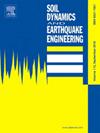The dynamic responses of undisturbed loess to seismic excitation: Centrifugal shaking table test
IF 4.2
2区 工程技术
Q1 ENGINEERING, GEOLOGICAL
引用次数: 0
Abstract
Undisturbed loess is highly sensitive to humidity and vibration. It is prone to serious seismic subsidence disasters under seismic loads. The dynamic responses and failure mechanisms of loess were investigated in centrifugal shaking table tests at different moisture contents and with different excitation amplitudes. The results show a significant acceleration amplification effect, especially at greater peak seismic accelerations and with drier soil. With the increase of excitation amplitude and moisture content, the degree of seismic settlement deformation becomes more significant and the risk of foundation instability increases. The shear action of seismic loading leads to the collapse of the undisturbed loess pore structure and the gradual densification of the skeletal structure, resulting in sudden additional settlement. With the loss of primary structure and the formation of secondary structure, the deformation process of seismic settlement of loess can be divided into four stages: elastic vibration, local shear, yield damage and deformation stabilization. The seismic subsidence damage form of undisturbed loess is dominated by vertical deformation and accompanied by the development of tension cracks caused by uneven settlement. The crushing phenomenon is serious in the local area, and may even trigger penetrating fracture damage.
原状黄土在地震作用下的动力响应:离心振动台试验
原状黄土对湿度和振动高度敏感。在地震荷载作用下,易发生严重的地震沉降灾害。通过离心振动台试验,研究了黄土在不同含水率和不同激励幅值下的动力响应及破坏机理。结果表明,加速度放大效应显著,特别是在地震峰值加速度较大和土壤较干燥的情况下。随着激励幅值和含水率的增大,地震沉降变形程度更加显著,地基失稳风险增大。地震荷载的剪切作用导致原状黄土孔隙结构坍塌,骨架结构逐渐致密化,产生突发性附加沉降。随着初级结构的丧失和次级结构的形成,黄土地震沉降的变形过程可分为弹性振动、局部剪切、屈服破坏和变形稳定四个阶段。原状黄土的地震沉降破坏形式以竖向变形为主,并伴有不均匀沉降引起的张拉裂缝的发育。局部破碎现象严重,甚至可能引发穿透性断裂损伤。
本文章由计算机程序翻译,如有差异,请以英文原文为准。
求助全文
约1分钟内获得全文
求助全文
来源期刊

Soil Dynamics and Earthquake Engineering
工程技术-地球科学综合
CiteScore
7.50
自引率
15.00%
发文量
446
审稿时长
8 months
期刊介绍:
The journal aims to encourage and enhance the role of mechanics and other disciplines as they relate to earthquake engineering by providing opportunities for the publication of the work of applied mathematicians, engineers and other applied scientists involved in solving problems closely related to the field of earthquake engineering and geotechnical earthquake engineering.
Emphasis is placed on new concepts and techniques, but case histories will also be published if they enhance the presentation and understanding of new technical concepts.
 求助内容:
求助内容: 应助结果提醒方式:
应助结果提醒方式:


